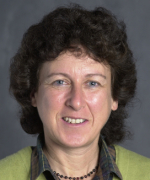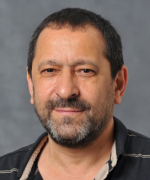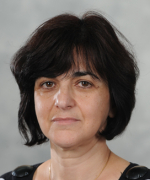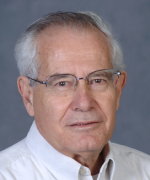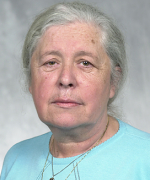Results for technologies (154)
AI-Powered Deep Phenotyping for Precision Drug Development (No. T4-2443)
Cyclic Capture of Atmospheric CO2 (No. T4-2433)
RF Resonators for Strong Driving of Nuclear Spins (No. T4-2431)
Dynamic VR-Based Motion Bio-Feedback Algorithm for Active CLP Exposure (No. T4-2420)
Synthetic Antimicrobial Peptides for Selective and Potent Malaria Treatment (No. T4-2408)
Computationally Designed Peroxygenases for Selective Terpene Oxyfunctionalization (No. T4-2403)
Early Detection of Liver Cirrhosis via Algorithmic Screening of EHR Data (No. T4-2392)
mAb mouse anti-Amphiregulin clone AR37 (No. M7-2388)
AI Based Decision Support System for Age related Macular Degeneration (AMD) and Diabetic Retinopathy (DR) (No. T4-2387)
Proteasome-Derived Defense Peptides (PDDPs) for Antimicrobial Therapy and Applications (No. T4-2372)
Modulo-Based High Dynamic Range ADC (No. T4-2371)
High-Resolution Microbial Profiling Across Unexplored Niches Using CoSMIC (No. T4-2368)
Colloidal Synthesis of Micron-Scale Organic Crystalline Spherulites (No. T4-2334)
Superconducting Quantum Memory with Tens of Milliseconds Coherence Time (No. T4-2333)
Serge ROSENBLUM
Compact Very High Energy Electron (VHEE) Radiotherapy for Deep-Seated Tumors (No. T4-2332)
Bruxno - Using Olfactory Biofeedback During Sleep to Reduce Sleep Bruxism (No. T4-2325)
Polymerization-Inducing Chimeras (PINCH) for Selective Target Inactivation (No. T4-2323)
Flexible Soft-Printed Synthetic and Bio-Polymer Films with Gold Nanoparticles (No. T4-2318)
Smart Energy Storage Devices with Visual Charge Monitoring (No. T4-2316)
Automated, Accurate Material Detection in Hyperspectral Data (No. T4-2281)
Aerobic Electrochemical Oxidation of Hydrocarbons (No. T4-2279)
Stirring-Free Scalable Electrosynthesis Enabled by Alternating Current (No. T4-2268)
Pmel-1 TCR transduced cells (No. M7-2265)
Time-Encoding Sub-Nyquist ADC (No. T4-2258)
Sparsity Based Non-Contact Vital Signs Monitoring of Multiple People Via Radar (No. T4-2257)
Task-Specific MIMO Communication Systems (No. T4-2255)
Nonlinear Waveform Inversion for Quantitative Ultrasound (No. T4-2254)
Cell line mutant in the R2-box region of the R2 gene (No. M7-2251)
GBA mice: a novel Gaucher disease (GD) model (No. M7-2249)
Nephrostomy Tube – A New Design to Decrease Dislodgement (No. T4-2230)
Yaniv Shilo
Anti importin beta1 monoclonal antibody (No. M7-2223)
Treating Malaria using Translation Initiation Inhibitors (No. T4-2220)
An Improved Single-Cell RNA-Sequencing Method (No. T4-2217)
Hyperstable Serum Albumin Variants for Microbial Mass Production (No. T4-2216)
Radiation Curing Enhancement by Semiconducting Nanoparticles (No. T4-2215)
High Throughput Screening Platform For Inhibitors of Viral Membrane Fusion (No. T4-2213)
Novel Molecules to Activate Immune Pathways (No. T4-2212)
Active Macrolide Antibiotic Compounds Against Pathogens (No. T4-2210)
GFP variants (No. M7-2209)
OM-17 cell line (high grade serous ovarian carcinoma) (No. M7-2202)
Green Synthesis of Biocompatible Porous Nanostructured Silica-Composite (No. T4-2201)
Enhancing Biofuel Production through Engineered Versatile Peroxidases (No. T4-2197)
Super Resolution Vascular Ultrasound Imaging for Clinical Diagnostics (No. T4-2194)
Parallax depth contrast for scanning probe transmission microscopy (No. T4-2193)
Splicing ViT Features for Semantic Appearance Transfer (No. T4-2192)
Ab289 (No. M7-2188)
Aliza Borenstein Katz
Zirconium Doped Ceria Electroceramic with a High Electrostriction Coefficient (No. T4-2180)
B16F10.9 Cell Line (No. M7-2179)
Bispecific Immune Synapse Engagers as Immunotherapy for Oncology and Autoimmunity (No. T4-2176)
Scalable method for braiding majorana modes in topological superconductor (No. T4-2172)
IPHOMED: A Functional Multi-Omics Platform for Decoding Host-Microbiome-Diet Interactions (No. T4-2160)
Novel Antibody Therapeutics Targeting Senescent Cells for Cancer and Fibrotic Disease Treatment (No. T4-2158)
MMP14 targeting natural antibodies to treat ovarian cancer (No. T4-2152)
Novel Combination Therapy For Improved Management of Depression (No. T4-2129)
Reusable Gold Nanostars Substrates for Signal Amplification for Diagnostics (No. T4-2127)
Modified Gabor Representation: A Powerful New Method forClassification and Compression of Audio, Images and Signals (No. T4-2100)
A Method for Vitamin D Production (No. T4-2086)
Modulating Weight Gain and Loss by Understanding the Mechanism of Smoking Related Weight Changes (No. T4-2078)
Biosynthetic pathways for producing Psychedelics (No. T4-2077)
Enhanced Anti-PD-L1 Immunotherapy (No. T4-2059)
Three Phases Topological Superconductivity (No. T4-2055)
Spin Current and Magnetoresistance from the Orbital Hall Effect (No. T4-2053)
YotiCurl Ureteral Stent (No. T4-2052)
Coupling of Alternating Current to Transition – Metal Catalysis (No. T4-2050)
Covalent Chemistry Platform for Diagnostics and Drug Discovery (No. T4-2045)
Protein coupling using cystein-free inteins (No. T4-2039)
Cell-free microRNA as a Prognostic Biomarker for Amyotrophic Lateral Sclerosis (ALS) (No. T4-2038)
Circulating microRNA Biomarkers for Early Frontotemporal Dementia Diagnosis (No. T4-2037)
Scarless CRISPR-mediated Genome Editing (No. T4-2036)
Safer CAR-T Cell Platform (No. T4-2033)
AI-Driven Discovery Platform for Immune Protein Inhibitors (No. T4-2027)
Carbon Nanotubes - Polymer Composites for Improved Mechanical and Electrical Properties (No. T4-1953)
Small Molecules for Treatment of Huntington's Disease and Related Disorders (No. T4-1947)
Artificial Pancreas (No. T4-1942)
New Antiviral Drugs from Bacterial Natural Products (No. T4-1934)
Higher Efficiency of CRISPR Gene Editing Using Chimeric Cas9 (No. T4-1930)
Novel TCRs against mutated KRAS, NRAS, and androgen receptor, and neoantigens identification platform (No. T4-1926)
Anti-LOX for the Treatment of Duchenne, Fibrosis and Cancer (No. T4-1913)
Iron Catalyzed Ring-Opening Metathesis Polymerization (ROMP) (No. T4-1905)
GreenTap - A Method for Stimulating Production and Extraction of Metabolites in Plants (No. T4-1894)
A Sustainable Process for Phenol Production (No. T4-1892)
Device for Electric Field Induced Local Magnetization (No. T4-1886)
Universal CAR-Ts for Treating Cancer (No. T4-1884)

Zelig Eshhar
Optical Bus for a Multi-Core Processor (No. T4-1863)
Super-Resolution Using Unsupervised Deep Internal Network (No. T4-1850)
Composite Functional Metasurfaces for Multispectral Achromatic Optics (No. T4-1845)
Secure Search of Encrypted Cloud Data (No. T4-1840)
A Method to Identify Actively Degraded Proteins (No. T4-1832)
Inertial NEMS for Nanosensor Applications Based on Inorganic Nanotubes (No. T4-1828)
Synthetic Immune Niche for Enhanced T Cell Expansion and Function (No. T4-1810)

Nir Friedman
Homogeneous Dispersion of CNT Composites for Improved Conductivity, Bucky Papers (No. T4-1809)
Microbiome-Based Prediction, Diagnosis, and Treatment of Relapsing Obesity (No. T4-1805)
Multimodel Transcranial Optical Vascular Assessment (No. T4-1769)

Alon Harmelin
Structure-Guided Antibiotic Discovery Platform for MRSA (No. T4-1760)
Carbon fixing bacteria (No. T4-1736)
Green Chemistry for Ketones and Aldehydes Production (No. T4-1722)
Highly Selective Optical Biosensors for Proteins in Biological Samples, with Excellent Signal-to-Noise Ratio (No. T4-1689)
Preventing Infections Using Lipid Based Molecules (No. T4-1673)
Magnetic resonance imaging (MRI) Of Tissue Fibrosis without Contrast Agent (No. T4-1665)
Optimized MAGE-A1 targeting TCR for T-cell Therapy (No. T4-1662)
Repurposing Enoxacin: A Novel Therapeutic Strategy Targeting miRNA Biogenesis in ALS (No. T4-1632)
Targeted Inhibition of ADAM17 for the Treatment of Inflammatory Diseases and Cancer (No. T4-1628)
Novel MRI Contrast Agent (No. T4-1604)
A Novel Database to Reduce Unsuccessful Cloning in E. Coli by Detection of Toxic Genes (No. M7-1576)
Inorganic Fullerene Coating For Medical Devices (No. T4-1566)
Green Catalytic Formation of Alcohols, Amines, Amides, Imines and Esters under Mild Conditions (No. T4-1551)
Highly Sensitive Nanoscale Scanning Magnetic and Thermal Sensor (No. T4-1481)
High-Performance Electrochromic Devices (No. T4-1380)
Mouse IgE and Anti-Mouse IgE Monoclonal Antibodies (No. M7-1270)

Zelig Eshhar
Cholesterol Antibodies (No. T4-1267)
Polyclonal anti human MUC2-D3 (No. M7-442)

Tal Ilani
Anti - gp100 T - cell Secreting Hybridoma [BUSA14 cell line] (No. M7-397)
Adi Sharbi-Yunger
Gal Cafri

Esther Tzehoval
Cntnap2 Tlacz/Tlacz Mice (No. M7-394)
Immortalized Prostate Cell Cultures PF179T-Prostate Fibroblasts h-TERT Immortalized Cells (No. M7-375)
Immortalized Prostate Cell Cultures PM151T-Prostate Muscle Cells h-TERT Immortalized Cells (No. M7-374)
Immortalized Prostate Cell Cultures EP156T-Epithelial Prostate h-TERT Immortalized Cells (No. M7-373)
Escherichia coli UTL2 (No. M7-358)
CNTNAP2 Knock Out Mouse Model for Human Diseases (No. M7-330)
Anti-Mast cell Function-associated Antigen (MAFA) monoclonal antibody (No. M7-320)
Anti-Runx-3 monoclonal antibody (No. M7-306)
CX3CR1-Cre ER Mice (No. M7-293)
CX3CR1-Cre Mice (No. M7-292)
Anti-Estrone-3-Glucuronide monoclonal antibody (clones: 155B3, 8A3) (No. M7-276)
Anti-Estrone-3-Glucuronide monoclonal antibody (No. M7-275)
Anti- estrone-3- glucuronide monoclonal antibody (No. M7-273)
499F (No. M7-265)

Luana Scheffer
Monoclonal Antibodies Specific to Cholesterol/Ceramide Mixture Clone (No. M7-263)

Luana Scheffer
Monoclonal Anti-Caspr Antibody (Mab#275) (No. M7-259)
Monoclonal Anti-Ermin Antibody (Mab#160) (No. M7-258)

Damian Brockschnieder
Monoclonal Anti-Gliomedin Antibody (Mab#94) (No. M7-257)
Anti-IgE monoclonal antibody (No. M7-185)

Michal Baniash

Zelig Eshhar
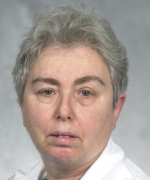
Tova Waks
Anti-Phospho-ERK (PY193 or PT115) Monoclonal Antibodies (No. M7-176)
Clone - 1E11 (No. M7-148)
Anti-Human chorionic gonadotropin (hCG) monoclonal antibody (No. M7-147)
Clone 1E11 Progesterone (No. M7-146)
Anti-oestradiol-6-carboxymethyl oxime monoclonal antibody (No. M7-141)
Anti-progesterone-7 monoclonal antibody (No. M7-138)
Human T3N1M1 prostatic adenocarcinoma tissue for xenograft (No. M7-132)
















